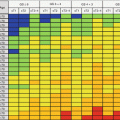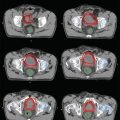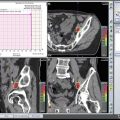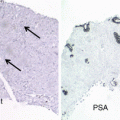Study
No of patients
Randomization
Results
RTOG 85-31 [31]
977
RT vs.
RT + LHRHa (continuous)
Combined arm is better in all end points
RTOG 86-10 [32]
456
RT vs.
RT + 4 month CAB
No significant difference in OS
GS 2–6 patients have better OS
RTOG 92-02 [33]
1554
RT + 4 month LHRHa vs.
RT + 2 year LHRHa
Long-term arm is better in all end points except OS
GS 8–10 patients have better OS with long-term LHRHa
EORTC 22863 [34]
415
RT vs.
RT + 3 year LHRHa
Combined arm is better in all end points
ADT was shown to be the most cost-effective therapy if started at the time that the patient developed symptomatic metastases [35] Thus ADT should be started immediately in case of symptomatic metastases in order to palliate symptoms and prevent complications; however, controversy still exists regarding asymptomatic metastatic patients because of the lack of high-quality studies.
20.7 Hormonal Treatment Combined with Chemotherapy
Three large RCTs compared ADT alone as the standard of care with ADT combined with immediate docetaxel (75 mg/m2 every 3 weeks; within 3 months of ADT initiation) in terms of OS [36–38].
In the GETUG-15 trial [36], all patients had newly diagnosed M1 prostate cancer, either primary or after a primary treatment. After a median follow-up of 83.9 months, updated results of GETUG-15 trial were published [37]. Median OS was 62.1 months and 48.6 months for ADT plus docetaxel and ADT arms, respectively (hazard ratio [HR]: 0.88 [95% CI, 0.68–1.14]; p = 0.3). Median OS in ADT plus docetaxel and ADT arms, respectively, was for high-volume disease (HVD) patients 39.8 months versus 35.1 months (HR: 0.78 [95% CI, 0.56–1.09]; p = 0.14) for low-volume disease (LVD) patients; median was not reached and 83.4 months (HR: 1.02 [95% CI, 0.67–1.55]; p = 0.9). For up-front metastatic patients, OS was 52.6 months and 41.5 months, respectively (HR: 0.93 [95% CI, 0.69–1.25]; p = 0.6). The bPFS (HR: 0.73 [95% CI, 0.56–0.94]; p = 0.014) and rPFS (HR: 0.75 [95% CI, 0.58–0.97]; p = 0.030) were significantly longer in the ADT plus D arm. Docetaxel should not be used as part of first-line treatment for patients with non-castrate metastatic prostate cancer.
In the CHAARTED trial [38], the same inclusion criteria applied. High-volume disease was defined as either presence of visceral metastases or four or more bone metastases, with at least one outside the spine and pelvis. After a median follow-up of 28.9 months, the median overall survival was 13.6 months longer with ADT plus docetaxel than with ADT alone (57.6 months vs. 44.0 months; p < 0.001). The median time to progression was 20.2 months in the combination group, as compared with 11.7 months in the ADT-alone group (p < 0.001). The rate of a prostate-specific antigen level of less than 0.2 ng/mL at 12 months was 27.7% in the combination group versus 16.8% in the ADT-alone group (p < 0.001). In the combination group, the rate of grade 3 or 4 febrile neutropenia was 6.2%, the rate of grade 3 or 4 infection with neutropenia was 2.3%, and the rate of grade 3 sensory neuropathy and of grade 3 motor neuropathy was 0.5%. It was concluded that ADT plus docetaxel for metastatic prostate cancer resulted in significantly longer overall survival than that with ADT alone.
STAMPEDE [39] was a multiarm, multistage trial including high-risk, locally advanced, metastatic, or recurrent prostate cancer who is starting first-line long-term hormone therapy. The standard of care (SOC) arm was ADT (n = 1184). The experimental arms were ADT combined with docetaxel (n = 593) and ADT combined with zoledronic acid (n = 593), and another was ADT combined with docetaxel and zoledronic acid (n = 593). Median follow-up was 43 months. Median overall survival was 71 months for SOC only, not reached for SOC + ZA (p = 0.450), 81 months for SOC + docetaxel (p = 0.006), and 76 months for SOC + ZA + docetaxel (p = 0.022). Grade 3–5 adverse events were reported for 399 (32%) patients receiving SOC, 197 (32%) receiving SOC + ZA, 288 (52%) receiving SOC + docetaxel, and 269 (52%) receiving SOC + ZA + docetaxel. Zoledronic acid showed no evidence of survival improvement, but docetaxel chemotherapy, given at the time of long-term hormone therapy initiation, showed evidence of improved survival accompanied by an increase in adverse events. Thus it was concluded that docetaxel treatment should become part of standard of care for adequately fit men commencing long-term hormone therapy. Table 20.2 summarizes the results of those four important trials.
Table 20.2
Hormonal treatment combined with chemotherapy in patients with metastatic disease
Study | No of patients | Median FU, months | Median OS, months (ADT + D vs. ADT) | p value |
|---|---|---|---|---|
Gravis et al. [36] | 385 | 50 | 58.9 vs. 54.2 | 0.955 |
Gravis et al. [37] | 385 | 82.9 | 60.9 vs. 46.5 | 0.44 |
Sweeney et al. [38] | 790 | 28.9 | 57.6 vs. 44 | <0.001 |
STAMPEDE trial [39] | SOC 1184 D 593 D + ZA 593 | 43 | 81 vs. 71 76 vs. NR 60 vs. 45 | 0.006 0.022 0.005 |
20.8 Side Effects of Hormonal Treatment
ADT has been shown to improve survival when used with radiation for patients with intermediate- and high-risk disease and locally advanced and node-positive disease. However it may cause side effects on bone, metabolic, cardiovascular, sexual, and cognitive health as well as body composition that negatively affect quality of life of patients.
20.8.1 Osteoporosis and Bone Fractures
ADT decreases bone mineral density (BMD). It was shown that ADT significantly increases risk for any clinical fracture, hip fractures, and vertebral fractures in men with prostate cancer, and the duration of treatment affects the onset of complications [40, 41]. Calcium (1000–1200 mg daily from diet and supplements) and vitamin D (800–1000 IU daily) are recommended to reduce the ADT side effects [42]) Osteoclast inhibition with either bisphosphonates or denosumab is recommended for men with bone metastases. Osteoclast inhibition can decrease bone turnover and increase bone mineral density in men receiving ADT [43].
20.8.2 Cardiovascular Events
The first report identifying a possible CV risk with LHRH agonists was by Keating et al., who analyzed the Surveillance, Epidemiology, and End Results (SEER) Medicare data of 73,196 men with locoregional prostate cancer [44]. A significantly increased risk of coronary heart disease, myocardial infarction, and sudden cardiac death was reported for men receiving an LHRH agonist compared with those not undergoing ADT. Prospective clinical trials have demonstrated that ADT may increase cardiovascular disease risk by increasing body weight, reducing insulin sensitivity, and/or resulting in dyslipidemia. In a prospective 12-month study of 40 men with prostate cancer, ADT increased serum total cholesterol, low-density lipoprotein cholesterol, high-density lipoprotein cholesterol, and triglycerides by 9%, 7%, 11%, and 27%, respectively [45].
It is advisable that patients in whom ADT is initiated be on periodic follow-up that includes assessment of blood pressure, lipid profile, and glucose level. Some of the effects of ADT occur within the first 3 months of treatment; thus it may be reasonable for an initial follow-up evaluation to occur within 3–6 months after initiation of therapy. There are no data to guide at what intervals periodic further follow-up should occur, and this is left to the discretion of the physician initiating ADT and to the patient’s primary care physician. Prudence and good medical care dictate that patients with cardiac disease receive appropriate secondary preventive measures as recommended by the American Heart Association and other expert organizations, including, when appropriate, lipid-lowering therapy, antihypertensive therapy, glucose-lowering therapy, and antiplatelet therapy [46].
20.8.3 Sexual Dysfunction
Since the incidence of prostate cancer is higher among older patients, at least one-third of men have sexual problems at diagnosis. However, most of the patients receiving continuous ADT who are potent prior to therapy develop sexual dysfunction. Loss of libido in patients receiving LHRH agonists usually develops within the first months followed by erectile dysfunction [47]. Erections do not recover in about one-half of men, even if ADT is discontinued. Although intermittent ADT allows some recovery of sexual function, serum testosterone requires 9–12 months off ADT to recover [48].
20.8.4 Vasomotor Symptoms
The most common symptom associated with ADT is hot flashes . Hot flashes are usually described as an intense sensation of warmth in the face and upper part of the body which seems similar to postmenopausal symptoms in women. The treatment should be decided depending on the degree of symptoms and potential side effects of the treatment. Megestrol and estrogen appear substantially more effective than venlafaxine. However, estrogen is associated with breast symptoms, megestrol is associated with increased appetite and weight, and venlafaxine is associated with dry mouth. It is recommended to start with a selective serotonin reuptake inhibitor and reserve hormonal treatment (estrogen, megestrol) for refractory cases.
20.8.5 Body Composition and Metabolism
A prospective study of 32 men receiving 12 months of GnRH agonists found a 2.4% weight gain, 9.4% increase in body fat percentage, and 2.7% decrease in lean body mass at 12 months [49]. Another prospective study of 25 patients without diabetes found that 12 weeks of combined androgen blockade resulted in a 12.8% decrease in insulin sensitivity and a 25.9% increase in fasting plasma insulin [50]. Basaria et al. conducted a cross-sectional study among 53 men, including 18 men with PCa who received ADT for at least 12 months prior to the onset of the study (the ADT group), 17 age-matched men with nonmetastatic PCa who had undergone prostatectomy and/or received radiotherapy and who were not receiving ADT (the non-ADT group), and 18 age-matched controls (the control group). It was shown that men on long-term ADT had significantly higher fasting glucose (131 vs. 103; p < 0.01) and greater insulin resistance (17 vs. 6; p < 0.01) and that 44% of the men on ADT had fasting glucose in the diabetic range (>126 mg/dL) compared with 11–12% for the controls [51].
Per the Adult Treatment Panel III (ATP III) guidelines, the diagnosis of metabolic syndrome requires the presence of three of the following five criteria: (1) serum triglycerides ≥150 mg/dL, (2) high-density lipoprotein (HDL) < 40 mg/dL, (3) fasting serum glucose >110 mg/dL, (4) waist circumference ≥ 40 inches, and (5) blood pressure ≥ 130/85 [52]. As noted earlier, patients receiving ADT are at risk for higher fasting serum glucose and increased waist size due to central weight gain. Triglycerides have also been reported to rise by 26.5% (±10%; p = 0.01) with 1 year of ADT [49]. There are currently no specific recommendations regarding the management of insulin resistance and lipid increases for men on ADT.
20.8.6 Gynecomastia
Gynecomastia and breast pain may be seen in patients on ADT. The incidence of gynecomastia was reported to be as high as 85% in patients receiving high-dose 150 mg daily bicalutamide antiandrogen monotherapy [53]. However, the incidence is lower (13–22%) in men receiving combined androgen blockade [54]. Di Lorenzo et al. investigated the role of tamoxifen and radiotherapy for the prevention and treatment of gynecomastia and breast pain during adjuvant bicalutamide monotherapy after RP in patients with prostate cancer [55]. It was shown that gynecomastia and breast pain induced by bicalutamide monotherapy after RP can be prevented and treated. Tamoxifen has been shown to be more effective and safe than RT (12 Gy) in this setting, and QOL and sexual function are not negatively influenced by these two treatment options. Ozen et al. investigated the efficacy of prophylactic radiotherapy for gynecomastia/breast pain induced by 150 mg bicalutamide in a prospective, randomized, multi-institutional trial [56]. After definitive treatment for localized prostate cancer, 125 patients were randomized to 12 Gy radiotherapy before bicalutamide as prophylactic radiotherapy or bicalutamide only for nonprophylactic radiotherapy. With a follow-up of 12 months, the gynecomastia rate was 15.8% in the prophylactic group and 50.8% in the nonprophylactic group (p < 0.001). Although prophylactic breast irradiation seemed to decrease the gynecomastia rate in patients on 150 mg bicalutamide, not all patients need prophylaxis since only 52% were significantly bothered by gynecomastia. Thus, it was recommended to select patients who need prophylactic radiation based on individual assessment.
20.8.7 Other
Fatigue is another side effect of ADT. The main strategy to reduce fatigue is exercise. Anemia and reduction in penile and testis size may be seen. Hypogonadism has been linked to cognitive declines in patients on ADT [57].
20.9 Follow-Up During Hormonal Treatment
EAU-ESTRO recommends follow-up of 3–6 month intervals. As a minimum, tests should include serum PSA measurement, physical examination, serum testosterone, and careful evaluation of symptoms to assess the treatment response and side effects. Patients should be warned about the signs of metastatic situations like occult cord compression, urinary tract complications/obstruction signs, and bone pain. Routine imaging is not indicated asymptomatic in patients. However, new-onset bone pain requires a bone scan, as does PSA progression suggesting CRPC status, if a treatment modification is considered [43].
The measurement of serum testosterone levels should be a part of follow-up of patients on LHRH therapy. Although timing of measurements is not clearly defined, a 3–6 month assessment of the testosterone level might be performed to evaluate the effectiveness of treatment and to ensure that the castration level is being maintained. If it is not achieved, switching to another type of treatment modality can be attempted. In patients with rising PSA and/or clinical progression, serum testosterone must be evaluated in all cases to confirm a castrate-resistant state.
Long-term ADT reduces bone mineral density (BMD) and increases the risk of fractures [58]. In the absence of associated risk factors, it is recommended that BMD and serum vitamin D and calcium levels should be measured every 2 years [59]. Patients should be screened for the development of alterations in lipid profiles and decreased insulin sensitivity [60]. ADT may increase the risk of diabetes and cardiovascular disease [61]. Patients should be given advice on modifying their lifestyle (e.g., diet, exercise, smoking cessation) and should be treated for any existing conditions, such as diabetes, hyperlipidemia, and/or hypertension. Furthermore, the risk–benefit ratio of ADT must be considered for patients with a higher risk of cardiovascular complications, especially if it is possible to delay starting ADT.
20.10 Castration-Resistant Prostate Cancer
CRPC is defined as castrate serum testosterone <50 ng/dl plus either biochemical or radiological progression. Biochemical progression is defined as three consecutive rises in PSA 1 week apart, resulting in two 50% increases over the nadir, and PSA >2 ng/mL. Radiological progression is defined as the appearance of new lesions, either two or more new bone lesions on bone scan or a soft tissue lesion using the Response Evaluation Criteria in Solid Tumors.
20.10.1 First-Line Treatment in Metastatic Castration-Resistant Prostate Cance r
Abiraterone was evaluated in 1088 chemonaïve metastatic CRPC patients in the phase 3 trial. Patients were randomized to abiraterone acetate or placebo, both combined with prednisone [62]. After a median follow-up of 22.2 months, there was significant improvement of radiographic PFS (median: 16.5 vs. 8.2 months; HR: 0.52; p < 0.001). At the final analysis, with a median follow-up of 49.2 months, the OS end point was significantly improved (34.7 vs. 30.3 months; HR: 0.81; 95% CI, 0.70–0.93; p = 0.0033) [63].
PREVAIL is a randomized phase 3 trial that included a similar patient population and compared enzalutamide with placebo. It was conducted in 1717 chemonaïve mCRPC patients and showed significant improvement in both radiographic PFS (HR: 0.186; 95% CI, 0.15–0.23; p < 0.0001) and OS (HR: 0.706; 95% CI, 0.6–0.84; p < 0.001). The most common clinically relevant AEs were fatigue and hypertension. The results showed that enzalutamide significantly decreased the risk of radiographic progression and death and delayed the initiation of chemotherapy in men with metastatic prostate cancer [64].
Stay updated, free articles. Join our Telegram channel

Full access? Get Clinical Tree








